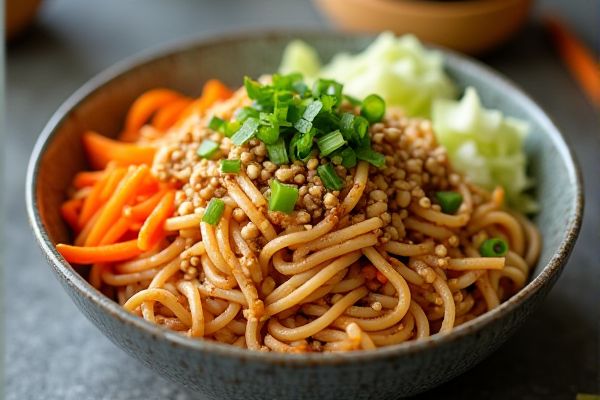
Thai Noodles from Noodles & Company feature tender rice noodles tossed in a savory peanut sauce, complemented by crisp cabbage, carrots, and green onions, finished with a sprinkle of crushed peanuts for a flavorful and crunchy bite.
Equipments
- Large pot
- Colander
- Large skillet or wok
- Mixing bowl
- Whisk
- Chef’s knife
- Cutting board
- Measuring cups
- Measuring spoons
- Tongs
- Spatula
- Serving bowls
Ingredients
- 8 oz (225g) rice noodles
- 1 cup shredded cabbage
- 1 cup shredded carrots
- 4 green onions
- 1/2 cup roasted peanuts
- 1/4 cup creamy peanut butter
- 3 tablespoons soy sauce
- 2 tablespoons brown sugar
- 2 tablespoons rice vinegar
- 1 tablespoon lime juice
- 1 tablespoon sesame oil
- 1 tablespoon sriracha sauce
- 2 cloves garlic
- 1 tablespoon vegetable oil
- Salt
- Black pepper
Rice noodles are essential for achieving the authentic texture in this dish, so be sure to select good-quality, tender rice noodles that cook quickly without becoming mushy. Use fresh shredded cabbage and carrots for optimal crunch and vibrant flavor. Roasted peanuts add a necessary crunch and depth, so avoid using raw peanuts or skipping them entirely. The peanut butter should be creamy and unsweetened to balance the sweetness from brown sugar and tanginess from lime juice and rice vinegar. Your homemade Thai Noodles from Noodles & Company copycat menu will have the perfect harmony of savory, sweet, tangy, and spicy flavors when you follow these ingredient suggestions.
Instructions
- Bring a large pot of salted water to a boil.
- Cook rice noodles according to package instructions; drain using a colander and set aside.
- Slice green onions, mince garlic, shred cabbage and carrots if not pre-shredded, and roughly chop peanuts.
- In a mixing bowl, whisk together peanut butter, soy sauce, brown sugar, rice vinegar, lime juice, sesame oil, sriracha sauce, and a splash of water until smooth.
- Heat vegetable oil in a large skillet or wok over medium-high heat.
- Add minced garlic and cook until fragrant, about 30 seconds.
- Add shredded cabbage and carrots, season with salt and black pepper, and stir-fry for 2-3 minutes until just tender.
- Add cooked rice noodles to the skillet.
- Pour in the prepared peanut sauce and toss everything together with tongs or a spatula until well coated and heated through.
- Add most of the green onions and toss again.
- Transfer noodles to serving bowls.
- Garnish with chopped peanuts and remaining green onions before serving.
Substitution
Thai Noodles from Noodles & Company deliver a delicious blend of tender rice noodles and peanut sauce with fresh vegetables and crunchy peanuts. If you don't have rice noodles, you can substitute with flat wheat noodles or even spaghetti, adjusting cooking time to avoid overcooking. When making the peanut sauce, natural peanut butter can be used instead of creamy, but whisk thoroughly to ensure a smooth texture. If sriracha sauce is unavailable, a dash of chili garlic sauce or red pepper flakes can add the needed heat and flavor. Your choice of veggies can be customized with bell peppers or snap peas for added crunch and nutrition.
Tips
Ensure rice noodles are not overcooked--follow package instructions carefully to maintain their tender texture without becoming mushy. When whisking the peanut sauce, add water gradually to achieve a smooth, pourable consistency that coats the noodles evenly. Use a large skillet or wok to allow plenty of space for stir-frying vegetables and noodles without crowding, which helps preserve the crispness of the cabbage and carrots. Before serving, taste and adjust seasoning with salt, pepper, or more lime juice to balance the flavors according to your preference.
Nutritions
Thai Noodles from Noodles & Company offer a balanced source of carbohydrates from tender rice noodles, providing sustained energy. The peanut sauce, made with creamy peanut butter and roasted peanuts, delivers healthy fats and protein essential for muscle repair and satiety. Fresh vegetables like cabbage, carrots, and green onions contribute dietary fiber, vitamins A and C, and antioxidants that support immune health. You can enjoy this flavorful meal while benefiting from a combination of macronutrients and micronutrients that promote overall wellness.
Storage
Store leftover Thai noodles in an airtight container to maintain freshness and prevent the peanut sauce from drying out. Refrigerate the container promptly, and consume within 3 to 4 days for best flavor and safety. When reheating, add a splash of water or additional peanut sauce to restore moisture and use a skillet over medium heat for even warming without clumping.
Variation or Alternatives
For a vegetarian variation, substitute soy sauce with tamari for a gluten-free option. You can replace the rice noodles with zucchini noodles or shredded cabbage for a low-carb alternative. Swap out sriracha with chili garlic sauce or omit it entirely for less heat. Your peanut sauce can be thickened by adding a small amount of coconut milk for a creamier texture.
Allergies
The peanut sauce and crushed peanuts in Thai Noodles from Noodles & Company pose a significant allergy risk for individuals with peanut allergies, which can cause severe reactions. Soy sauce contains soy, another common allergen, while sesame oil introduces the potential for sesame allergies. You should carefully review the ingredients and consult with restaurant staff if you have any food allergies or sensitivities to ensure your safety.
Why this recipe?
Thai Noodles from Noodles & Company combines bold flavors of peanut sauce, fresh vegetables, and tender noodles, creating a perfect balance of savory, sweet, and spicy tastes. The dish features authentic ingredients like crushed peanuts and fresh cilantro, delivering a genuine Thai-inspired experience that appeals to diverse palates. You will appreciate how this menu item offers a satisfying and healthy option, rich in protein and customizable with different proteins like chicken or tofu. Making the copycat version allows you to recreate this flavorful, restaurant-quality meal at home with fresh ingredients and control over spice levels.
